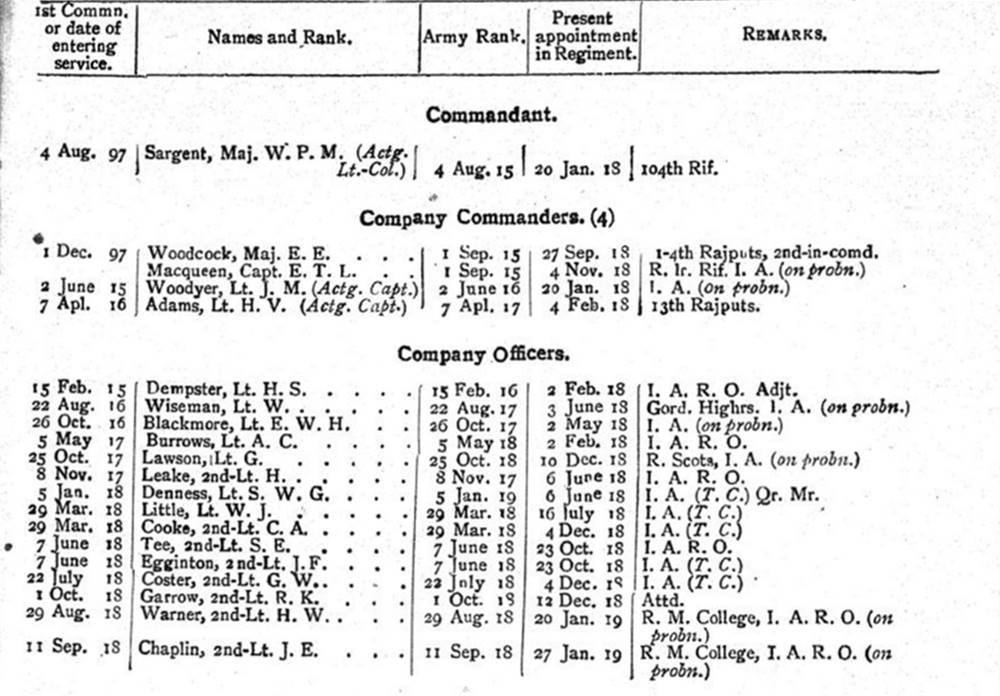This article is about the short-lived 2nd Battalion 11th Rajputs and will help you to research the Regiment and a soldier who served with it during the First World War. I have also written an article on the 1st Battalion 11th Rajputs and a series of guides to help you to research a soldier who served in the First World War:
The 2nd Battalion 11th Rajputs
Lineage: The 2nd Battalion 11th Rajputs was formed at Sitapore, now Sitapur in the present day Indian state of Uttar Pradesh on 20 January 1918 and disbanded on 31 May 1920. For a history of the Regiment’s lineage see my page on the 1st Battalion 11th Rajputs.
Class Composition of Battalion in 1914: 4 Companies of Rajputs.
The 2nd Battalion 11th Rajputs was a war-raised Indian infantry battalion formed at Sitapore on 20 January 1918. The Battalion was part of the 4th Quetta Division which did not serve outside of India during the First World War. The Battalion was initially commanded by Lieutenant-Colonel William Patrick Miller Sargent appointed from the 104th Wellesley Rifles, and subsequently Lieutenant-Colonel Henry Oswald Bell Wood appointed from the 8th Rajputs on 15 June 1919. Both were long-serving Indian Army officers with extensive military service: Wood in South Africa and on the North West Frontier; Sargent in Aden and Somaliland. By December 1918 the Battalion was stationed at Lucknow where it was still serving in early 1919. During this period, the Battalion was inspected by Brigadier-General Henry de Courcy O’Grady who commanded the 10th Infantry Brigade. This was the only confidential report written for the unit and was dated between 10 and 12 April 1919:
Turn-out: Fair.
Drill: Reasonably smart.
Manoeuvre: Fair.
Musketry: Satisfactory.
Signalling: Satisfactory.
Fire Discipline: Fair
Bombing: Fair.
Physical Training: Fair.
Lewis Guns: Good.
Health: Fair.
Conduct: Satisfactory.
Interior Economy: Well looked after.
General Observations – The regiment is not yet fit for war. The material is good and all that is required is time and opportunity to make an efficient unit.
Lieutenant General Richard Wapshare, C.B., C.S.I., Commanding the 4th (Quetta) Division reported:
A satisfactory report. The regiment has done good and continuous work in convoy duty. The regiment is now reported medically unfit for active service.
Confidential review reports on Indian Army units, depots, British officers, etc. for 1919-1920: IOR/L/MIL/7/17031.
While at Lucknow, the Battalion was ordered to disband but the Third Anglo-Afghan War broke out on 6 May which stopped the disbandment, at least temporarily. The Battalion served with Baluchistan Force during the war but there is no war diary so tracing its movements will be difficult. While serving in the war, the Battalion’s Depot was at Loralai. On 16 January 1920, the Battalion was ordered to disband and the process took some months. By March 1920, the Battalion was stationed at Sibi and in June was at Quetta. At some point later in the year, the Battalion was disbanded. Below is an extract from the April 1919 Indian Army List recording the British officers who were serving with the Battalion. There were only two pre-war British Indian Army officers with the Battalion with the others tending to be either from the Indian Army Reserve of Officers (I.A.R.O.) or holding a Temporary Commission (T.C.).
War Diaries of the 2nd Battalion 11th Rajputs
A war diary was written by a British officer of a unit and recorded its location and activities. Unfortunately, there are no war diaries for the 2nd Battalion 11th Rajputs.
Further Sources for the 2nd Battalion 11th Rajputs
The Indian Army List will give information regarding British and Indian officers who served with the Battalion. The confidential report quoted from above is actually quite poor and can be found at the British Library: Confidential review reports on Indian Army units, depots, British officers, etc. for 1919-1920: IOR/L/MIL/7/17031. This confidential report also contains the annual reports of the British officers serving with the Battalion.

